最新2014中考英语语法总复习讲义
- 格式:doc
- 大小:367.50 KB
- 文档页数:26
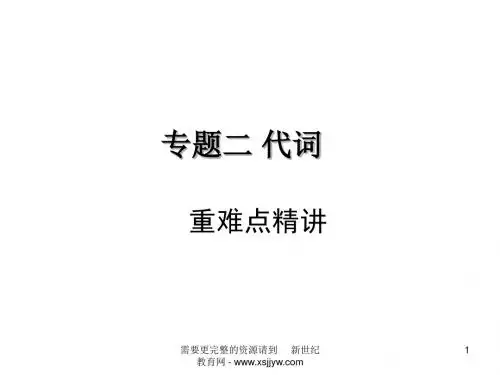
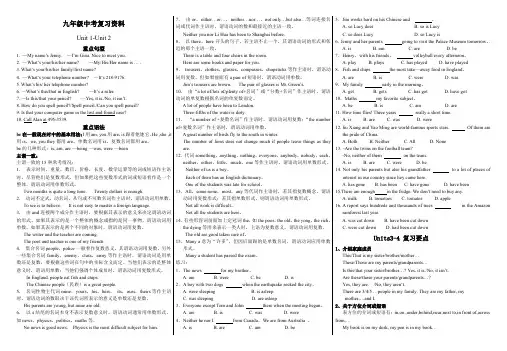
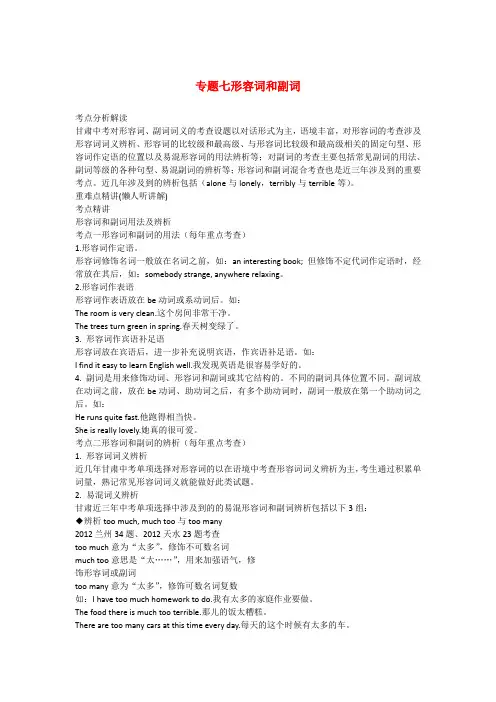
专题七形容词和副词考点分析解读甘肃中考对形容词、副词词义的考查设题以对话形式为主,语境丰富,对形容词的考查涉及形容词词义辨析、形容词的比较级和最高级、与形容词比较级和最高级相关的固定句型、形容词作定语的位置以及易混形容词的用法辨析等;对副词的考查主要包括常见副词的用法、副词等级的各种句型、易混副词的辨析等;形容词和副词混合考查也是近三年涉及到的重要考点。
近几年涉及到的辨析包括(alone与lonely,terribly与terrible等)。
重难点精讲(懒人听讲解)考点精讲形容词和副词用法及辨析考点一形容词和副词的用法(每年重点考查)1.形容词作定语。
形容词修饰名词一般放在名词之前,如:an interesting book; 但修饰不定代词作定语时,经常放在其后,如:somebody strange, anywhere relaxing。
2.形容词作表语形容词作表语放在be动词或系动词后。
如:The room is very clean.这个房间非常干净。
The trees turn green in spring.春天树变绿了。
3. 形容词作宾语补足语形容词放在宾语后,进一步补充说明宾语,作宾语补足语。
如:I find it easy to learn English well.我发现英语是很容易学好的。
4. 副词是用来修饰动词、形容词和副词或其它结构的。
不同的副词具体位置不同。
副词放在动词之前,放在be动词、助动词之后,有多个助动词时,副词一般放在第一个助动词之后。
如:He runs quite fast.他跑得相当快。
She is really lovely.她真的很可爱。
考点二形容词和副词的辨析(每年重点考查)1. 形容词词义辨析近几年甘肃中考单项选择对形容词的以在语境中考查形容词词义辨析为主,考生通过积累单词量,熟记常见形容词词义就能做好此类试题。
2. 易混词义辨析甘肃近三年中考单项选择中涉及到的的易混形容词和副词辨析包括以下3组:◆辨析too much, much too与too many2012兰州34题、2012天水23题考查too much意为“太多”,修饰不可数名词much too意思是“太……”,用来加强语气,修饰形容词或副词too many意为“太多”,修饰可数名词复数如:I have too much homework to do.我有太多的家庭作业要做。

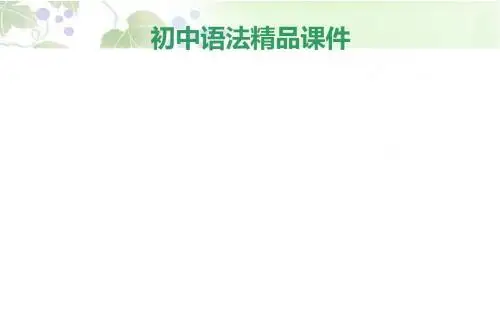
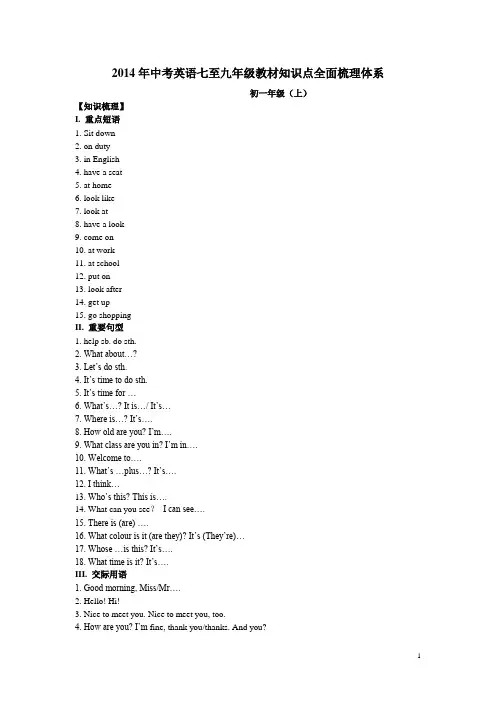
2014年中考英语七至九年级教材知识点全面梳理体系初一年级(上)【知识梳理】I. 重点短语1. Sit down2. on duty3. in English4. have a seat5. at home6. look like7. look at8. have a look9. come on10. at work11. at school12. put on13. look after14. get up15. go shoppingII. 重要句型1. help sb. do sth.2. What about…?3. Let‟s do sth.4. It‟s time to do sth.5. It‟s time for …6. What‟s…? It is…/ It‟s…7. Where is…? It‟s….8. How old are you? I‟m….9. What class are you in? I‟m in….10. Welcome to….11. What‟s …plus…? It‟s….12. I think…13. Who‟s this? This is….14. What can you see?I can see….15. There is (are) ….16. What colour is it (are they)? It‟s (They‟re)…17. Whose …is this? It‟s….18. What time is it? It‟s….III. 交际用语1. Good morning, Miss/Mr….2. Hello! Hi!3. Nice to meet you. Nice to meet you, too.4. How are you? I‟m fine, thank you/thanks. And you?5. See you. See you later.6. Thank you! You‟re welcome.7. Goodbye! Bye!8. What‟s your name? My name is ….9. Here you are. This way, please.10. Who‟s on duty today?11. Let‟s do.12. Let me see.IV. 重要语法1. 动词be的用法;2. 人称代词和物主代词的用法;3. 名词的单复数和所有格的用法;4. 冠词的基本用法;5. There be句型的用法。
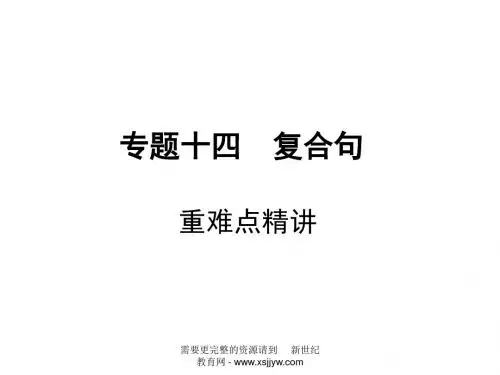
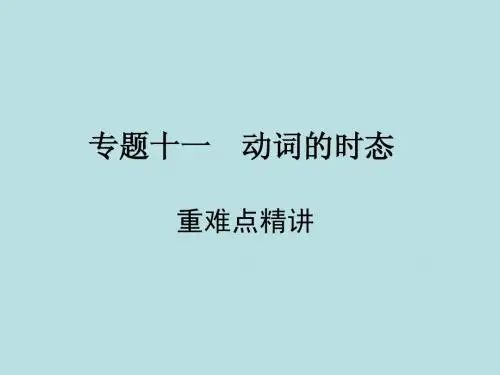
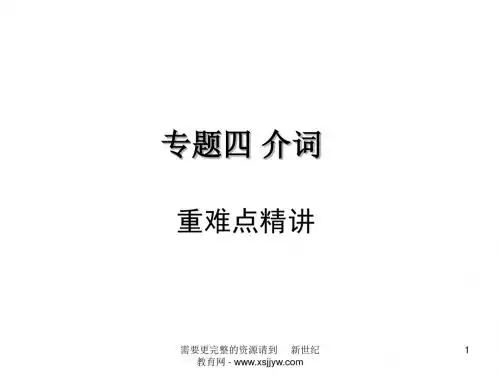
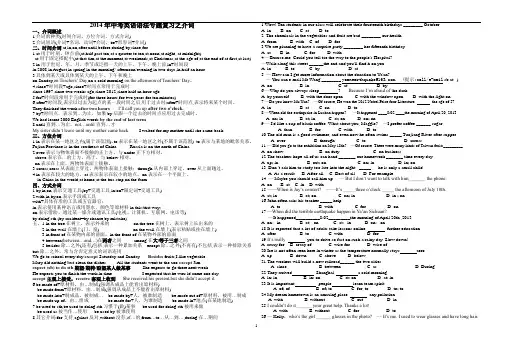
2014年中考英语语法专题复习之介词一、介词概述1.介词的种类(时间介词、方位介词、方式介词)2.介词短语(介词+名词,动词+介词,be+形容词+介词)二、时间介词at,in,on,after,until,before,during,by,since,for1.at用于时刻、钟点前(at half past ten,at a quarter to ten,at noon,at night, at midnight)at用于固定搭配中(at that tim,at the moment,at weekends,at Christmas,at the age of,at the end of,at first,at last) 2.in用于世纪、年、月、季节或泛指一天的上午、下午、晚上前,in+时间段in 2008,in August,in spring,in the morning/ afternoon/evening,in two days,in half an hour3.具体到某天或具体到某天的上午、下午和晚上on Sunday,on Teachers’ Day,on a cold morning,on the afternoon of Teachers’ Day。
4.since+时间段+ago,since+时间点常用于完成时since 1997,since two weeks ago,since 2012,since half an hour ago5.for+时间段常用于完成时(for three hours,for two years,for ten minutes)6.after+时间段,表示以过去为起点的某一段时间之后,用于过去时:after+时间点,表示将来某个时间。
They finished the work after two hours. I’ll call you up after two o’clock.7.by+时间点,表示到…为止,如果by后跟一个过去的时间点应用过去完成时。

名词1、 名词的分类专有名词单数名词表泛指,在前面加a /an.可数名词:有单数和复数之分普通名词 复数形式通常加 -s/-es 不可数名词:没有复数形式 物质名词、抽象名词、专有名词 用some/any/a little/a lot of 修饰2) 不规则变化①有些名词以-s结尾,但表达单数意义。
科学名词:physics, mathematics/maths 游戏名称:bowls专有名词:the United States, Niagara Falls 其他名词:news, falls②名词做定语,不用复数形式.e.g. a shoe shop, an apple tree*例外:man, woman作定语时,如果后面的名词是复数,则man, woman也要变。
e.g. a woman teacher → three women teachersa man doctor → many men doctors③people, police做“人们”讲时,看作复数,不能在后面加”-s”,谓语动词用复数形式。
family, class是集体名词,既指单数,又指复数,谓语动词可用单数亦可用复数,具体根据语境而定。
④其前不用冠词a/an或数词,但可用much, a little, a lot of/lots of, some,—Look at the clouds, so beautiful!—Wow, so many different _______, horses, sheep, flowers…A. sizesB. shapesC. colorsD. stylesThere are some _______ in Dayton Art Museum. For example, n o food or drink is allowed inside.A. jobsB. recordsC. rul esD. paintings—Yesterday, my father bought me a new mobile phones as a pr esent, but I don’t know how to use it.—Why not read the _______ first before using it?A. expressionsB. applicationsC. adve rtisementsD. instructionsThese _________ have saved many children’s lives.A. woman doctorsB. women doctorC. women doctorsD. woman doctor---What would you like to drink, _______or orange? ---Orange, please.A. hamburgerB. chipC. tea3、不可数名词的数1) 可以修饰不可数名词的词或短语:a lot of , lots of, some, a little, little2) 数词+ 量词 + of + 不可数名词e.g. a glass of water → two glasses of watera cup of tea → three cups of tea3) 常用的不可数名词food, meat, fish, chicken, pork, beef, mutton, orange, milk, tea, coke, water, rice, bread, homework, news, paper, ice, rain, snow, wind, cloud, air, weather, maths, Chinese, English, music, information, fun, work 等.4) 有些不可数名词以复数形式出现时,意思有变化.5) 有些名词,既可以作可数名词,又能做不可数名词,但含义不同Exercises:—Mum, I’ve heard that we can’t eat ____ those days. Is it true?—Take it easy. It is safe to eat cooked meat.A. chickenB. chickensC. a chickenD. the chickenThe students of Grade 7 visited Mike’s farm and saw many ___ there.A. birdB. duckC. sheepD. rabbitI’m so hungry. Please give me ___ to eat.A. three breadB. three pieces of breadC. three pieces ofbreads D. three piece of breadI want a sweet milk. Put some ______ in my cup, please.A. iceB. soupC. saltD. sugar—What a good ______ you’ve given me! Thanks a lot.—My pleasure.A. informationB. newsC. suggestion D. advice4、名词的所有格分类构成方法例子表示有生命的名词所有格在单数后面加-’s The teacher’s officeLily’s photo 以加-s的复数名词后加“’”The teachers’ officeBoys’ games 不以-s 结尾的复数名词后加“-’s”The children’s palace.用and 连接两个并列的单数名词表示共有时,在后一个词尾加-’s;如果不是,则需要分别加在两个名词后面。
2014年中考英语语法总复习(精华版)Ⅰ词类。
专有名词:表示人名、月份、日期、地名等。
如China, John, London, the USA,Harbin .个体名词:表示单个的人或事物。
如boat, chair, desk, apple .集体名词:表示一群人或一些事物的总称。
如family, people, class, police . 可数名词普通名词物质名词:表示无法分为个体的物质。
如water, air, tea, sea, money, cotton .抽象名词:表示抽象概念的词。
如health, help, work, friendship . 不可数名词2.名词的数。
可数名词有单复数,不可数名词没有单复数。
3.名词的格:名词有三个格:主格(作主语)、宾格(作宾语)、和所有格。
其中只有名词的所有格有形式变化。
(二)冠词1.定冠词-the .○1特指某(些)人或某(些)事物。
The students are very good.○2说话人与听话人都知道的人或事物。
Where is the toilet ?○3重复提到上文的人或事物。
I have a cat , the cat is white and black .○4表示世界上独一无二的事物。
The moon moves around the earth .○5形容词最高级和序数词前和表示方位的名词前。
I am the oldest . He is the first to school . I live in the south .○6乐器的名称前常用定冠词-the 。
I like playing the piano / violin .○7和某些形容词连用,使形容词名词化,代表某一类人。
We should help the poor .○8放在某些专有名词前。
We will go to visit the Great Wall next week . the people’s Republic of China .○9放在姓氏的复数形式前,表示全家人或夫妇两人。
专题一名词名词是中考考查的重点。
考查内容主要为:1. 名词单、复数的变化规律及其用法;2. 不可数名词量的表达法;3. 名词所有格的变化及其用法;4. 名词作主语的一致问题;5. 常用专有名词的表示法;6. 具体语境中名词的词义和一些常用易混淆名词的区别。
Ⅰ.名词的定义名词是表示人、事物、现象和其他抽象概念的名称的词。
名词可分为专有名词和普通名词。
专有名词是具体的人和事物等特有名称。
专有名词的第一个字母要大写,人名、地名、公共节日及月份、周日的名称等等都是属于专有名词。
(见资料)如:Yao Ming 姚明;China 中国;Christmas 圣诞节等。
Ⅱ. 可数名词和不可数名词普通名词按照其所表示的事物的性质分为可数名词和不可数名词。
1.可数名词可数名词有单数和复数两种形式。
如:an apple; two apples 。
★注意:a 用于以辅音音素( 指音标) 开头的单数名词前;an 用于以元音音素( 指音标) 开头的单数名词前。
如:a book/b uk/, a useful/ju:sful/ book ,an apple/’aepl/ ,a red apple , an hour/’aua/2.不可数名词: 不可数名词包括物质名词和抽象名词,没有复数形式。
(1)物质名词。
如:water; rice; tea; milk; food; fruit; meat; fish(鱼肉); chicken(鸡肉); beef; mutton; orange(橙汁);sugar; salt; paper(纸); porridge; bread; sand; juice等。
这类不可数名词需要计量时要在名词前加表示量的词。
如:a cup of tea; two bags of rice; three bottles of water等。
(2)抽象名词。
如:news; music; time(时间); information等。
(3)不可数名词不能与数词或不定冠词连用。
(4)注意有些名词既可做可数名词也可做不可数名词。
如:fish; time; glass; orange; room; noise; chicken等。
但使用时一定要区分它们表达的不同意义。
Ⅲ. 名词的数(1)元音或词尾发生变化如:man→men; woman→women; Frenchman→Frenchmen; tooth→teeth; foot→feet; child→children(2)单复数形式相同如:sheep→sheep; fish→fish; Chinese→Chinese; Japanese→Japanese; yuan→yuan(3)形式为单数意思为复数如:people,police(集合名词)(4)形式为复数意思为单数如:news, maths, physics, the United States等。
(5)只用复数形式如:pants, shorts, clothes,glasses(眼镜)等。
3. 不可数名词的量的表示:(不能直接用数字;不能直接加a。
an;无复数形式)(1)表不定数量时,一般用much,(a)little, a lot of/lots of, some, any等词修饰。
(2)表确定数量时,一般用―数词+量词+of+不可数名词。
如:a piece of paper, a piece of news, a bag of rice, two glasses of milk, four bottles of waterⅣ.名词的所有格:1. 有生命的名词所有格(1) 单数名词后加’s 。
如:my brother’s book(2) 不以s 结尾的复数名词后加’s 。
如:the children’s football(3) 以s 结尾的复数名词后加’ 。
如:the boys’ game(4) 以s 结尾的专有名词后直接加’ 。
如:Dickens’ novels(5)某物为两个名词共有时,在第二个名词后加’s : 如:To m and David’s room.(6) 表示两个名词各自拥有的东西,在两个名词后都加’s: 如:Tom’s and David’s rooms.2. 无生命的事物的名词所有格(of所有格)(1)of+名词。
如:a photo of my family, the door of the classroom注意:“of+名词’s/名词性物主代词” 构成双重所有格如:a friend of mine, a friend of Jim’s。
(2) 表示时间或距离,国家,城市的方法。
也可用’s来构成所有格▲如:ten minutes’ drive十分钟车程;a month’s holiday一个月的假期。
China’s capital(3)表称呼、职业等名词的所有格可以表示人的住所或工作场所。
所有格后面的名词一般被省去。
如:at his brother’s; at the doctor’s; at the barker’s; at Mr Read’s(4)用所有格表示节日的方法:如:Teachers’ Day; Children’s Day.(除了父亲节和母亲节其他节日我们都用名词复数的所有格表示。
)如:Mother’s Day; Father’s Day.▲(5).由some、any、no、every与one、body 结合的复合不定代词something 、anything 等和else 连用时,所有格应加在else的后面。
This is _________________(somebody else ) pencil .四、名词作句子成分:★1.名词作主语1).表示时间、金钱、距离作主语时,谓语动词用单数。
Two hours _______(be) enough for us to get there .2).量词短语“数字+量词+ of +…”作主语时,谓语动词应与量词保持一致。
A pair of shoes _______(be) under the bed . Two pieces of paper _______(be) on the desk .3).名词+介词(with、except 、along with ….)+名词作主语时,谓语动词应与前面的名词保持一致。
The teacher with the students _________(be) planting trees on the hill .4).短语“neither…nor…、either…or…、not only…but also …‖连接主语时,谓语动词实行就近原则。
Neither he nor I ______ (be) a Frenchman .★2.名词作定语1).名词作定语时,一般用单数形式。
变复数时,名词中的中心词变为复数形式。
如:a banana tree→banana trees; a shoe factory→shoe factories There is a shoe factory near the school .2).名词作定语时,个别情况用复数形式。
(sport )The sports meeting will be held next week .3).man、woman 作定语表示性别时,man、woman随后面的名词单复数而变。
one man teacher two women teachers专题二冠词中考对冠词的考查主要为:不定冠词a和an的用法,定冠词the的用法,零冠词的用法,习惯用语中冠词的位置及使用。
Ⅰ.冠词的定义冠词是虚词。
通常放在名词之前,用来说明名词所表示的人或事物。
冠词分为不定冠词(a和an)和定冠词(the)两类。
Ⅱ.冠词的用法1.不定冠词a, an的用法(1)泛指某人或某物,但不具体说明何人或何物。
A girl is waiting for you.(2)不定冠词a 用在以辅音音素开头的单数可数名词前;a useful book; a desk;不定冠词an 用在以元音音素开头的单数可数名词前。
如:an old man; an actor; an “m”。
(3)第一次提到某人或某物而非特指时。
如:There is a book on the desk, but the book isn’t mine.(4)表示人或事物的某一类。
如:An elephant is bigger than a tiger.(5)用于表时间、速度、价格等意义的名词之前,有“每一”的意思,相当every 如:three times a week.(6) 表示数量,有“一”的意思,但数的概念没有one强烈。
I have a computer.(7)用在序数词前,表示“又一,再一”I have three books. I want to buy a fourth one.(8)可视为一个整体的两个名词前eg: a knife and fork 一副刀叉(9)用在某些固定词组中:如:have a good time; have a swim ,have a cold , half an hour ,a lot(of), after a while , in a hurry , fora long time, a few ,a little ,at a time ,2.定冠词the的用法(1)用来特指某人或某物,双方都知道的人或物的名词前如:Open the door, please.(2)用于上文提到的某人或某物。
There is a kite on the wall. The kite is new.(3)表示世界上独一无二的事物的名词前如:the sun; the moon; the earth; the sky(4)用在序数词或形容词最高级前,如:March is the third month of a year. He is the cleverest boy in his class.(5)用在某些形容词前,表示一类人。
如:the rich; the poor; the young; the old等。
(6)用在西洋乐器名词前。
如:play the violin(7)用在表示方位的名词前。
如:in the east/north/west/south(8)用在表示山脉、海洋、江河、湖泊、群岛、建筑物、名胜古迹等专有名词前或用在由普通名词构成的专有名词前。
如:the Yellow River; the Great Wall; the West Lake; the White House等(9)用在姓氏复数形式前,表示“全家人”或“夫妻俩”。